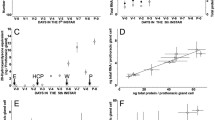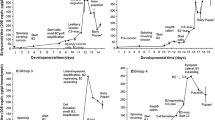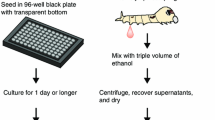Summary
Chironomus tentans cells were cultured in the presence of gradually increasing concentrations of 20-OH-ecdysone or a nonsteroidal molting hormone agonist, the benzoylhydrazine RH 5992, for a period of about 2 yr. From these cultures, subclones were selected, which are resistant to up to 25 µM 20-OH-ecdysone according to morphological (changes in cell shape and cell arrangement) and physiological criteria (acetylcholinesterase induction, secretion of chitinolytic enzymes, thymidine incorporation). Some subclones, selected in the presence of 20-OH-ecdysone, are resistant only to molting hormone, but still respond to RH 5992 morphologically and biochemically, whereas subclones selected in the presence of the benzoylhydrazine showed no reaction neither to 20-OH-ecdysone nor to the hormone agonist. Hormone resistance is stable; 3 mo. after hormone withdrawal, resistant clones still do not respond to renewed exposure to 20-OH-ecdysone or RH 5992, respectively. Because in all resistant subclones tested so far all hormonally regulated responses known from sensitive cells were no longer detectable, it is assumed that the hormone signaling pathway itself is interrupted. Possible mechanisms of hormone resistance were discussed.
Similar content being viewed by others
References
Apple, R. T.; Fristrom, J. W. Regulation of pupal cuticle gene expression during metamorphosis in Drosophila melanogaster. In: Ohnishi, E.; Ishizaki, H., eds. Molting and metamorphosis. Tokyo: Japan Scientific Societies Press; 1990:223–237.
Baumeister, R. M.; Ludwig, M.; Spindler-Barth, M. Hormonal regulation of dopadecarboxylase activity and chitin synthesis in an epithelial cell line from Chironomus tentans. Naturwissenschaften 79:185–187; 1992.
Bradford, M. M. A rapid and sensitive method for the quantitation of microgram quantities of protein utilizing the principle of protein-dye binding. Anal. Biochem. 72:248–254; 1976.
Courgeon, A.-M. Action of insect hormones at the cellular level: morphological changes of a diploid cell line of Drosophila melanogaster, treated with ecdysone and several analogues in vitro. Exp. Cell Res. 74:327–336; 1972.
Courgeon, A.-M. Action of insect hormones at the cellular level. II. Differing sensitivity to β-ecdysone of several lines and clones of Drosophila melanogaster cells. Exp. Cell Res. 94:283–291; 1975.
Imhoff, M. O.; Rusconi, S.; Lezzi, M. Cloning of a Chironomus tentans cDNA encoding a protein (cEcRH) homologous to the Drosophila melanogaster ecdysteroid receptor (dEcR). Insect Biochem. Mol. Biol. 23:115–124; 1993.
Koelle, M. R.; Talbot, W. S.; Segraves, W. A., et al. The Drosophila EcR gene encodes an ecdysone receptor, a new member of the steroid receptor superfamily. Cell 6:59–77; 1991.
Lammerding-Köppel, M.; Spindler-Barth, M.; Drews, U. Ecdysone-induced morphogenetic movements are forshadowed and accompanied by expression of an embryonic muscarinic system in a Chironomus cell line. W. Roux’s Arch. Dev. Biol. 203:439–444; 1994.
Quack, S.; Fretz, A.; Spindler-Barth, M., et al. Receptor affinity and biological response of nonsteroidal ecdysteroid agonists on the epithelial cell line from Chironomus tentans. Eur. J. Entomol. 92:341–347; 1995.
Shemshedini, L.; Wilson, T. G. Resistance to juvenile hormone and an insect growth regulator in Drosophila is associated with an altered cytosolic juvenile hormone binding protein. Proc. Natl. Acad. Sci. USA 87:2072–2076; 1990.
Spindler, K.-D.; Spindler-Barth, M. Inhibition of chitinolytic enzymes from Streptomyces griseus (fungi), Artemia salina (crustacea), and a cell line from Chironomus tentans (insecta) by allosamidin and isoallosamidin. Pestic. Sci. 40:113–120; 1994.
Spindler-Barth, M. Hormonal regulation of acetylcholinesterase in an epithelial cell line from Chironomus tentans. Z. Naturforsch. 46c:1089–1093; 1991.
Spindler-Barth, M. Endocrine strategies for the control of ectoparasites and insect pest. Parasitol. Res. 78:89–95; 1992.
Spindler-Barth, M. Hormonal regulation of chitin metabolism in insect cell lines. In: Muzzarelli, R. A. A., ed. Chitin enzymology. Ancona, Italy: Eur. Chitin Soc.; 1993;75–82.
Spindler-Barth, M.; Junger, E.; Spindler, K.-D. Vesicle formation and ecdysteroid-induced cellular differentiation in the epithelial cell line from Chironomus tentans. Tissue & Cell 24:919–934; 1992.
Spindler-Barth, M.; Junger, E.; Spindler, K.-D. The epithelial cell line from Chironomus tentans: hormonal regulation of tissue differentiation and cuticle formation. Actes de Colloque 18:87–93; 1995.
Spindler-Barth, M.; Kammann, V.; Spindler, K.-D. Hormonal regulation of chitin synthesis in two insect cell lines. In: Skjak-Braek, G.; Anthonson, T.; Sandford, P., eds., Chitin and chitosan. London: Elsevier Applied Science; 1989;279–289.
Spindler-Barth, M.; Schmidt, H.; Drews, U., et al. Increase in activity of acetylcholinesterase by 20-OH-ecdysone in a Chironomus tentans cell line. Roux’s Arch. Dev. Biol. 197:366–369; 1988.
Spindler-Barth, M.; Turberg, A.; Spindler, K.-D. On the action of RH 5849, a nonsteroidal ecdysteroid agonist, on a cell line from Chironomus tentans. Arch. Insect Biochem. Physiol. 16:11–18; 1991.
Stevens, B.; O’Connor, J. D. The acquisition of resistance to ecdysteroids in cultured Drosophila cells. Dev. Biol. 94:176–182; 1982.
Turberg, A.; Spindler-Barth, M.; Lutz, B., et al. Presence of an ecdysteroid-specific binding protein (“receptor”) in epithelial tissue culture cells of Chironomus tentans. J. Insect Physiol. 34:797–803; 1988.
Wing, K.-D. RH 5849, a nonsteroidal ecdysone agonist: effects on a Drosophila cell line. Science 241:467–469; 1988.
Wing, K.-D.; Aller, H. E. Ecdysteroid agonists as novel insect growth regulators. In: Casida, J. E., ed. Presticides and alternatives: innovative chemical and biological approaches to pest control. Amsterdam, Netherlands: Elsevier Science Publishers; 1990;251–257.
Wing, K.-D.; Slawecki, R. A.; Carlson, G. R. RH 5849, a nonsteroidal ecdysone agonist: effects on larval Lepidoptera. Science 241:470–472; 1988.
Wyss, C. Chironomus tentans epithelial cell lines sensitive to ecdysteroid, juvenile hormones, insulin and heat shock. Exp. Cell Res. 139:309–319; 1982.
Author information
Authors and Affiliations
Rights and permissions
About this article
Cite this article
Spindler-Barth, M., Spindler, KD. Ecdysteroid resistant subclones of the epithelial cell line from Chironomus Tentans (insecta, diptera). I. Selection and characterization of resistant clones. In Vitro Cell.Dev.Biol.-Animal 34, 116–122 (1998). https://doi.org/10.1007/s11626-998-0093-y
Received:
Accepted:
Issue Date:
DOI: https://doi.org/10.1007/s11626-998-0093-y




